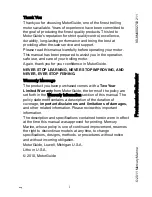
EVGA Z270 Stinger (111-KS-E272)
- 99 -
Assume your speakers are not full-range. Modern speaker design uses a
subwoofer to handle the relatively small percentage of content you hear in an
audio signal. Low frequency content, more commonly known as sub-bass, is
greatly amplified by the subwoofer, which explains why the smallest percentage
of your audio content can often be the loudest. The subwoofer allows the
speakers to concentrate on the remaining 99%+ of the audible frequency
bandwidth.
• Generally, if your speakers came with a subwoofer, they are not full-range
speakers. As noted above, subwoofers are designed, in part, to allow speakers
to stay clear of the low frequencies. When examining the specs of the speakers,
make sure to look at the frequency response specifically of the speakers, and not
just the specs of the speaker system. Sometimes, the most easily available specs
may include the subwoofer, which can go as low as 18Hz +/-2 dB; the
minimum frequency of the speakers, however, may be much higher.
• If you have a 2.0 stereo setup, look for the frequency response specs. If they do
not have at least a 20Hz to 20kHz range, then they are not full-range speakers.
You may try full-range, but you will lose any audio data below the minimum
frequency of your speakers or may hear distortion at lower frequencies.
• Headphones tend to be full-range speakers, as they are designed to operate
without a subwoofer. However, the quality of your headphones will determine
whether you should configure them as full-range or not.
• If you use a receiver or your speaker system has its own controls for the type of
speakers, do not use the full-range setting in the Creative panel without
consulting the instructions of your receiver or speaker system, since it’s possible
that your receiver or speakers prefers full-range, so that the receiver or speaker
system will utilize its own crossover settings once receiving the full audio range.
• Lastly, audio equipment quality will have the greatest effect on whether you
should set full-range, or not. Very few speakers are properly designed for full-
range audio, and if they are, then they will likely be very expensive.
Two last considerations: First, do not set Headphones to full-range if using the
Headphone Surround option (may be listed as Virtual Surround), as Surround will not
work properly in full-range mode. Second, do not enable full-range mode for 5.1 audio
or the bass redirection will not work properly. The only exceptions to 5.1 and full-range
is that you either 1) have a full or partial set of full-range speakers in your setup, or 2)
you are using a receiver or speaker system that prefers to handle the low frequency
crossover at the receiver or speaker system, rather than using the Audio Manager to
configure the crossover settings for low frequencies.
Summary of Contents for Z270 Stinger
Page 1: ...EVGA Z270 Stinger 111 KS E272 1 User Guide EVGA Z270 Stinger Specs and Initial Installation ...
Page 71: ...EVGA Z270 Stinger 111 KS E272 71 ...
Page 123: ...EVGA Z270 Stinger 111 KS E272 MEMO ...
Page 124: ...EVGA Z270 Stinger 111 KS E272 MEMO ...
Page 125: ...EVGA Z270 Stinger 111 KS E272 MEMO ...
Page 126: ...EVGA Z270 Stinger 111 KS E272 MEMO ...
Page 127: ...EVGA Z270 Stinger 111 KS E272 MEMO ...
Page 128: ......
















































